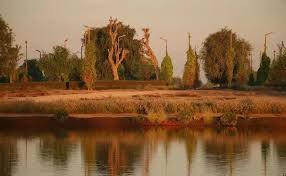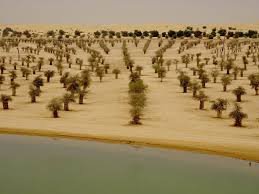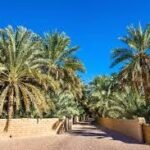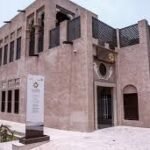Deep in the Al Qudra Desert, far from Dubai’s glittering skyline, stands a solitary ghaf tree that has become the subject of spine-chilling legends. Known locally as “The Cursed Tree of Al Qudra,” this twisted, isolated specimen is the only tree for miles in the barren desert, its very existence defying logic. While Dubai is famous for its record-breaking architecture and luxury attractions, this unassuming tree holds a darker reputation – one woven with tales of jinn, tragic deaths, and inexplicable phenomena that have made it one of the UAE’s most feared locations. Unlike the manicured parks of the city, this tree grows in complete isolation, its gnarled branches casting eerie shadows across the dunes as if warning visitors to stay away.
The Cursed Tree of Al Qudra: A Botanical Anomaly in the Desert
The Cursed Tree’s most baffling aspect is its solitary survival in an area devoid of vegetation. Ghaf trees typically grow in groups where their roots can tap into underground water, yet this specimen stands alone, with no visible water source for miles. Scientists have struggled to explain how it continues to thrive, with some suggesting its roots might stretch impossibly deep into hidden aquifers. The tree’s isolation has fueled supernatural theories, with Bedouin elders claiming it was “placed there by unseen hands.” During summer months when temperatures exceed 50°C, the tree’s leaves remain unnaturally green while the surrounding desert becomes a lifeless oven, adding to its mysterious reputation.
The Dark Legends of The Cursed Tree of Al Qudra
Local folklore tells multiple versions of how the tree became cursed. One account speaks of a jilted lover who hanged himself from its branches, his spirit forever bound to the tree. Another tells of a Bedouin woman who cursed the tree after being abandoned there by her tribe. The most chilling version involves a 1970s incident where a group of campers allegedly vanished near the tree, with only their abandoned belongings found neatly arranged beneath its branches. Regular visitors to Al Qudra Lakes report that GPS devices malfunction when approaching the tree, and some claim their phones capture shadowy figures in photos that weren’t visible to the naked eye. These stories have been passed down through generations of Emiratis, with many refusing to visit the site after sunset.
Paranormal Encounters and Unexplained Phenomena
Documented paranormal activity around the tree ranges from subtle to terrifying. Nighttime visitors frequently report hearing whispers in classical Arabic when no one else is present. Desert safari guides tell of clients who experienced sudden temperature drops near the tree, even in peak summer heat. In 2018, a group of paranormal investigators claimed their equipment recorded a woman’s scream at 3:17 AM – a time considered spiritually significant in Arab culture. Perhaps most disturbingly, several visitors have reported seeing the tree’s branches move violently when there was no wind, with some describing the movements as “reaching” toward them. These accounts have led to the tree being marked on some maps with a warning symbol, though no official restrictions exist.
The Tree’s Connection to Ancient Beliefs
The Cursed Tree’s reputation taps into deep-seated regional beliefs about solitary trees in desert landscapes. Ancient Bedouin traditions held that isolated trees often served as meeting places for jinn – supernatural beings made of smokeless fire in Islamic theology. Historical records show that similar “cursed trees” were documented across the Arabian Peninsula, with travelers offering small sacrifices to appease the spirits believed to inhabit them. The Al Qudra tree fits this pattern perfectly, standing at what some claim is a crossroads of invisible energy lines. Modern visitors still sometimes find strange offerings – bundles of herbs, small coins, or handwritten prayers – tied to its lower branches, suggesting these ancient traditions continue today.

The Instagram Paradox: Beauty and Danger
Despite its ominous reputation, the Cursed Tree has become an unlikely Instagram hotspot during daylight hours. Its photogenic silhouette against endless dunes attracts influencers and photographers, many unaware of its dark history. However, locals note an unsettling pattern – a disproportionate number of visitors who post disrespectful or mocking photos at the site later report strange misfortunes, from car accidents to unexplained illnesses. This has led to an unofficial etiquette among desert explorers: always ask permission before photographing the tree, and never take anything from its base. Some professional photographers swear their best shots of the tree show unexplained anomalies – strange lights or misty figures that weren’t present during the shoot.
Scientific Explanations vs. Supernatural Beliefs
Skeptics have proposed rational explanations for the tree’s phenomena. The GPS malfunctions could result from magnetic mineral deposits in the soil. Temperature fluctuations might be caused by unique wind patterns around the tree’s isolated form. Even the infamous “whispers” could theoretically be the sound of wind through the tree’s unusually shaped leaves. However, these explanations fail to account for the consistency of experiences across different visitors, or why similar phenomena don’t occur around other isolated desert trees. A 2020 geological survey revealed nothing unusual about the site’s composition, deepening rather than solving the mystery. This scientific ambiguity leaves room for both skeptics and believers to interpret the tree’s secrets as they choose.
Visiting The Cursed Tree of Al Qudra: Etiquette and Warnings
For those determined to visit, the tree is accessible via Al Qudra Road, though its exact coordinates are intentionally vague on most maps. Experienced desert guides recommend visiting only in daylight, bringing a companion, and avoiding physical contact with the tree. There’s an unspoken rule among regular visitors never to camp within sight of the tree, as numerous accounts tell of campers being “visited” by shadowy figures at night. The most important rule, according to local tradition, is to leave the tree as you found it – taking souvenirs like branches or leaves is considered extremely bad luck. While no official restrictions exist, Dubai Police have occasionally warned thrill-seekers about the dangers of desert exploration after several rescues were needed for visitors who became disoriented near the site.
The Enduring Enigma of Dubai’s The Cursed Tree of Al Qudra
In a city known for constantly reinventing itself, the Cursed Tree remains a stubborn mystery, untouched by development or tourism campaigns. Its continued survival against all odds mirrors the persistence of the legends surrounding it. Whether viewed as a supernatural entity, a psychological phenomenon, or simply a remarkable natural wonder, the tree serves as a reminder that even in Dubai’s hyper-modern landscape, some mysteries resist explanation. As long as its gnarled branches continue to twist toward the desert sky, the Cursed Tree of Al Qudra will likely keep its secrets – and its warnings – to itself. For now, it stands as a silent sentinel in the sands, challenging visitors to separate fact from folklore in one of the UAE’s most enduring paranormal puzzles.
Go to main page


